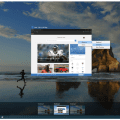Multiple Desktops
How to use multiple desktops in Windows 10

If you’re a single-monitor user — or even if you’re not — multiple virtual desktops can be very handy. While Windows has supported this feature for some time Windows 10 is the first time we see multiple desktops as a mainstream feature.
In the Windows 10 Pro Insider Preview, you can add a seemingly unlimited number of virtual desktops quickly and easily, thanks to the new Task View pane. Unfortunately, Windows 10’s multiple desktop functionality is still very limited — you can’t drag and drop programs between different screens, you can’t change the wallpaper for individual desktops, and you can’t quickly jump to a particular screen without cycling through all of your open screens.
Step 1: Add a desktop

To add a virtual desktop, open up the new Task View pane by clicking the Task View button (two overlapping rectangles) on the taskbar, or by pressing the Windows Key + Tab. In the Task View pane, click New desktop to add a virtual desktop. If you have two or more desktops already open, the “Add a desktop” button will appear as a gray tile with a plus symbol. You can also quickly add a desktop without entering the Task View pane by using the keyboard shortcut Windows Key + Ctrl + D.
Step 2: Switch between desktops
To switch between virtual desktops, open the Task View pane and click on the desktop you want to switch to. You can also quickly switch desktops without going into the Task View pane by using the keyboard shortcuts Windows Key + Ctrl + Left Arrow and Windows Key + Ctrl + Right Arrow. At the moment, you can add an unlimited number of virtual desktops — I stopped at 368 — but there doesn’t appear to be a way to quickly switch to a certain desktop without cycling through all of them with the keyboard shortcuts. The Task View pane only shows nine desktops at a time and has no scrolling functionality, which is likely a bug that will be fixed in the final version of Windows 10.
Step 3: Move windows between desktops

To move a window from one desktop to another, you first have to open up the Task View pane and then hover over the desktop containing the window you want to move. The windows on that desktop will pop up; find the window you want to move, right-click it, and go to Move to and choose the desktop you want to move the window to. In Build 10166, Microsoft has added the ability to drag and drop windows — you can grab the window you want to move and drag it into the desired desktop.
Step 4: Close a desktop

To close a virtual desktop, open up the Task View pane and hover over the desktop you want to close until a small X appears in the upper right corner. Click the X to close the desktop. You can also close desktops without going into the Task View pane by using the keyboard shortcut Windows Key + Ctrl + F4 (this will close the desktop you’re currently on).